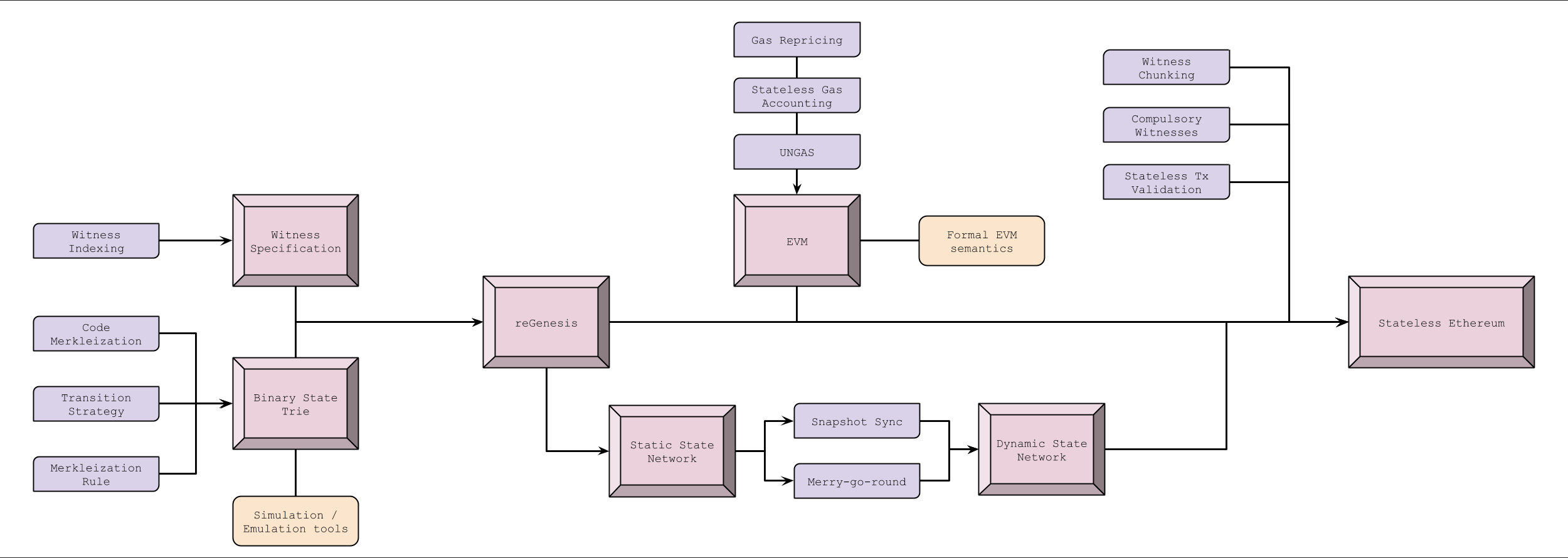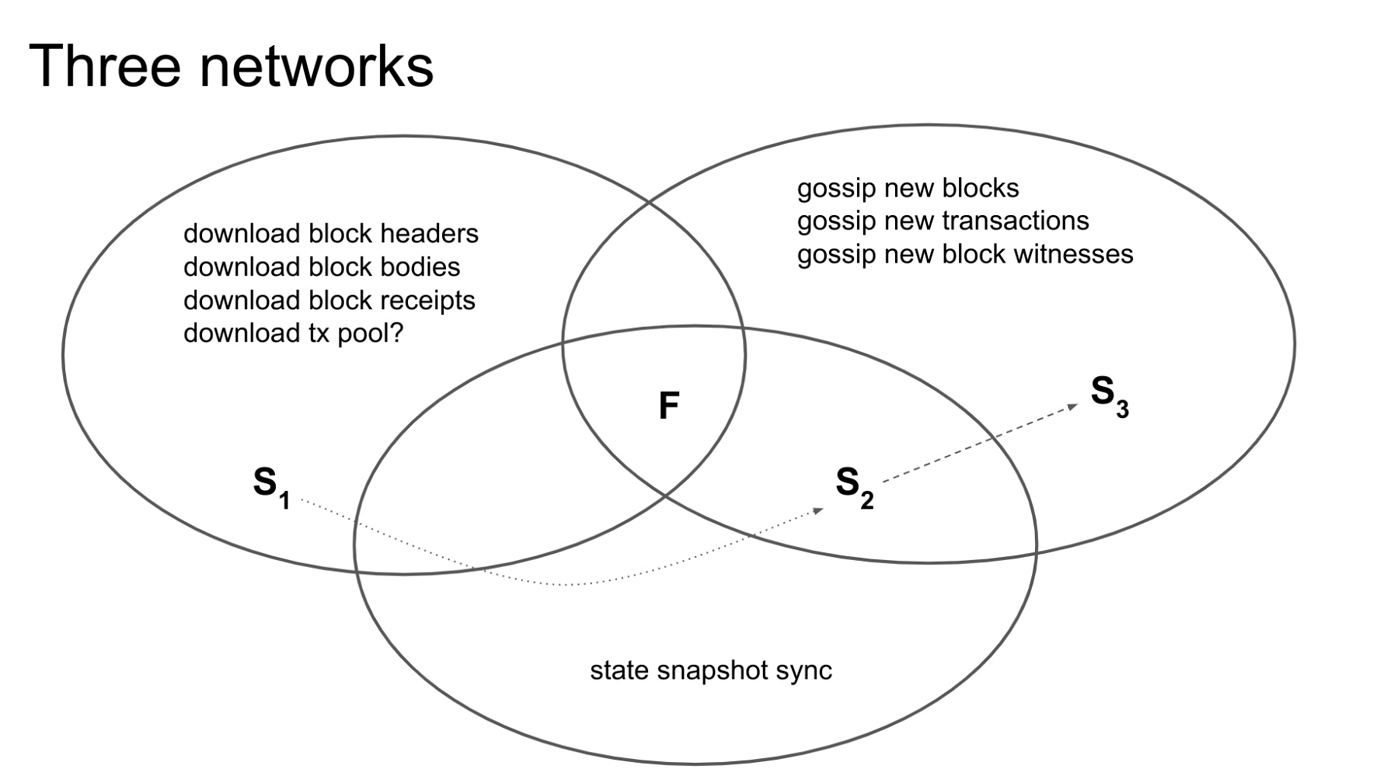[ad_1]
This week we’re revising the Tech Tree to mirror some new main milestones to Ethereum 1.x R&D that aren’t fairly an entire realization of Stateless Ethereum, however way more moderately attainable within the mid-term. Essentially the most vital addition to the tech tree is Alexey’s reGenesis proposal. That is removed from a well-specified improve, however the common sentiment from R&D is that reGenesis affords a much less dramatic but way more attainable step in direction of the last word aim of the “absolutely stateless” imaginative and prescient. In some ways complimentary to reGenesis is a static state community that may assist distribute state snapshots and historic chain information in a bittorrent-style DHT-based community. On the identical time, extra near-term enhancements like code merkleization and a binary trie illustration of state are getting nearer and nearer to being EIP-ready. Beneath, I am going to clarify and make clear the modifications which have been made, and hyperlink to the related discussions if you would like to dive deeper on any specific function.

Binary Trie
Whereas Ethereum at present makes use of a hexary Merkle-Patricia Trie to encode state, there are substantial effectivity beneficial properties available by switching to a binary format, significantly within the anticipated measurement of witnesses. A whole re-encoding of Ethereum’s state requires the brand new format to be specified, and a transparent technique for transition. Lastly, it must be determined whether or not or not good contract code can even be merkleized, and if that needs to be included into the binary trie transition or as a standalone change.
Binary Trie Format
The final concept of a binary trie is a bit less complicated (pun supposed :)) than Ethereum’s present hexary trie construction. As an alternative of getting one in all 16 doable paths to stroll from the basis of the trie down in direction of little one nodes, a binary trie has 2. With an entire re-specification of the state trie comes further alternative to enhance upon well-established inefficiencies which have made themselves recognized now that Ethereum has been in operation for greater than 5 years. Particularly, it is likely to be a possibility to make the state way more amenable to the real-world efficiency challenges of database encoding (outlined in a previous article on state growth).
The dialogue on a proper binary trie specification and merkleization guidelines will be discovered on ethresearch.
Binary Trie Transition
It isn’t simply the vacation spot (binary trie format) that is essential, however the journey itself! In a really perfect transition there could be no interruption to transaction processing throughout the nework, which implies that purchasers might want to construct the brand new binary trie on the identical time as dealing with new blocks rolling in each 15 seconds. The transition technique that continues to look probably the most promising is dubbed the overlay method, which is predicated partially on geth’s new snapshotting sync protocol. Briefly abstract, new state modifications might be added to the prevailing (hexary) trie in a binary format, making a type of binary/hexary hybrid through the transition. The un-touched state is transformed as a background course of. As soon as the conversion is full, the 2 layers get flattened right into a single binary trie.
It is essential to notice that the binary transition is one context wherein consumer range is essential. Each consumer might want to both implement their very own model of the transition or depend on different purchasers to transform and anticipate the brand new trie on the opposite aspect of conversion. It will positively be a ‘measure twice, lower as soon as’ type of state of affairs, with all consumer groups working collectively to implement check, and coordinate the switchover. It’s doable that within the curiosity of security and safety, the community might want to briefly droop service (e.g. mine a number of empty blocks) over the course of the transition, however agreeing on any particular plan is just too far out to foretell presently.
Code Merkleization
Sensible Contract code makes up a good portion of the Ethereum state trie (round 1 GB of the ~50GB of state). A witness for any good contract interplay will essentially have to supply the code it is interacting with to calculate a codeHash, and that may very well be numerous additional information. Code Merkleization is a method of splitting up contract code into smaller chunks, and changing codeHash with the basis of one other merkle trie. Doing so would permit a witness to interchange doubtlessly massive parts of good contract code with reference hashes, shaving off essential kilobytes of witness information.
There are a number of approaches to code merkleization schemes, which vary from chunking universally (for instance, into 64 byte items) on the easy aspect to extra complicated strategies like static evaluation based mostly on Solidity’s functionId or JUMPDEST directions. The optimum technique for code merkleization will in the end depend on what appears to work finest with actual information collected from mainnet.
reGenesis
One of the best place to get a deal with on the reGenesis proposal is this explanation by @mandrigin or the full proposal by @realLedgerwatch, however the TL;DR is that reGenesis is basically “spring cleansing for the blockchain”. The complete state could be conceptually divided into an ‘energetic’ and an ‘inactive’ state. Periodically, all the ‘energetic’ state could be de-activated and new transactions would begin to construct an energetic state once more from virtually nothing (therefore the identify “reGenesis”). If a transaction wanted an previous a part of state, it could present a witness similar to what could be required for Stateless Ethereum: a Merkle proof proving that the state change is in keeping with some piece of inactive state. If a transaction touches an ‘inactive’ portion of the state, it mechanically elevates it to ‘energetic’ (whether or not or not the transaction is profitable) the place it stays till the subsequent reGenesis occasion. This has the good property of making a few of the financial bounds on state utilization that state lease had with out truly deleting any state, and permitting transaction sender unable to generate a witness to only blindly preserve making an attempt a transaction till every little thing it touches is ‘energetic’ once more.
The enjoyable half about reGenesis is that it will get Ethereum a lot nearer to the last word aim of Stateless, however sidesteps a few of the largest challenges with Statelessness, i.e. how witness fuel accounting works throughout EVM execution. It additionally will get some model of transaction witnesses shifting across the community, permitting for leaner, lighter purchasers and extra alternative for dapp builders to get used to the stateless paradigm and witness manufacturing. “True” Statelessness after reGenesis would then be a matter of diploma: Stateless Ethereum is basically simply reGenesis after each block.
State Community
A greater community protocol has been a ‘side-quest’ on the tech tree from the start, however with the addition of reGenesis to the scope of Stateless Ethereum, discovering different community primitives for sharing Ethereum chain information (together with state) now appears to suit quite a bit higher into the primary quest. Ethereum’s present community protocol is a monolith, when in truth there are a number of distinct varieties of information that may very well be shared utilizing completely different ‘sub-networks’ optimized for various issues.

Beforehand, this has been talked about because the “Three Networks” on earlier Stateless calls, with a DHT-based community in a position to extra successfully serve a few of the information that does not change from second to second. With the introduction of reGenesis, the ‘inactive’ state would match into this class of unchanging information, and may very well be theoretically served by a bittorrent-style swarming community as an alternative of piece-by-piece from a completely synced consumer as is at present carried out.
A community passing across the un-changing state because the final reGenesis occasion could be a static state community, and may very well be constructed by extending the brand new Discovery v5.1 spec in the devp2p library (Ethereum’s networking protocol). Earlier proposals akin to Merry-go-Round sync and the (extra mature) SNAP protocol for syncing energetic state would nonetheless be precious steps towards a completely distributed dynamic state community for purchasers making an attempt to quickly sync the total state.
Wrapping up
A extra condensed and technical model of each leaf within the Stateless Tech Tree (not simply the up to date ones) is obtainable on the Stateless Ethereum specs repo, and energetic discussions on all the matters coated listed here are within the Eth1x/2 R&D Discord – please ask for an invitation on ethresear.ch if you would like to hitch. As at all times, tweet @gichiba or @JHancock for suggestions, questions, and recommendations for brand spanking new matters.
[ad_2]

